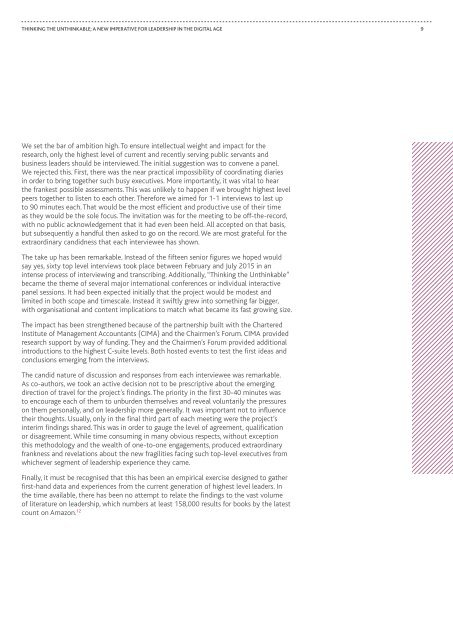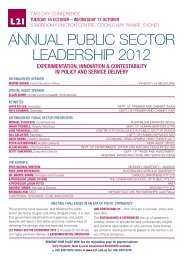Thinking the Unthinkable
Thinking-the-Unthinkable-cima-report
Thinking-the-Unthinkable-cima-report
Create successful ePaper yourself
Turn your PDF publications into a flip-book with our unique Google optimized e-Paper software.
THINKING THE UNTHINKABLE; A NEW IMPERATIVE FOR LEADERSHIP IN THE DIGITAL AGE<br />
9<br />
We set <strong>the</strong> bar of ambition high. To ensure intellectual weight and impact for <strong>the</strong><br />
research, only <strong>the</strong> highest level of current and recently serving public servants and<br />
business leaders should be interviewed. The initial suggestion was to convene a panel.<br />
We rejected this. First, <strong>the</strong>re was <strong>the</strong> near practical impossibility of coordinating diaries<br />
in order to bring toge<strong>the</strong>r such busy executives. More importantly, it was vital to hear<br />
<strong>the</strong> frankest possible assessments. This was unlikely to happen if we brought highest level<br />
peers toge<strong>the</strong>r to listen to each o<strong>the</strong>r. Therefore we aimed for 1-1 interviews to last up<br />
to 90 minutes each. That would be <strong>the</strong> most efficient and productive use of <strong>the</strong>ir time<br />
as <strong>the</strong>y would be <strong>the</strong> sole focus. The invitation was for <strong>the</strong> meeting to be off-<strong>the</strong>-record,<br />
with no public acknowledgement that it had even been held. All accepted on that basis,<br />
but subsequently a handful <strong>the</strong>n asked to go on <strong>the</strong> record. We are most grateful for <strong>the</strong><br />
extraordinary candidness that each interviewee has shown.<br />
The take up has been remarkable. Instead of <strong>the</strong> fifteen senior figures we hoped would<br />
say yes, sixty top level interviews took place between February and July 2015 in an<br />
intense process of interviewing and transcribing. Additionally, “<strong>Thinking</strong> <strong>the</strong> <strong>Unthinkable</strong>”<br />
became <strong>the</strong> <strong>the</strong>me of several major international conferences or individual interactive<br />
panel sessions. It had been expected initially that <strong>the</strong> project would be modest and<br />
limited in both scope and timescale. Instead it swiftly grew into something far bigger,<br />
with organisational and content implications to match what became its fast growing size.<br />
The impact has been streng<strong>the</strong>ned because of <strong>the</strong> partnership built with <strong>the</strong> Chartered<br />
Institute of Management Accountants (CIMA) and <strong>the</strong> Chairmen’s Forum. CIMA provided<br />
research support by way of funding. They and <strong>the</strong> Chairmen’s Forum provided additional<br />
introductions to <strong>the</strong> highest C-suite levels. Both hosted events to test <strong>the</strong> first ideas and<br />
conclusions emerging from <strong>the</strong> interviews.<br />
The candid nature of discussion and responses from each interviewee was remarkable.<br />
As co-authors, we took an active decision not to be prescriptive about <strong>the</strong> emerging<br />
direction of travel for <strong>the</strong> project’s findings. The priority in <strong>the</strong> first 30-40 minutes was<br />
to encourage each of <strong>the</strong>m to unburden <strong>the</strong>mselves and reveal voluntarily <strong>the</strong> pressures<br />
on <strong>the</strong>m personally, and on leadership more generally. It was important not to influence<br />
<strong>the</strong>ir thoughts. Usually, only in <strong>the</strong> final third part of each meeting were <strong>the</strong> project’s<br />
interim findings shared. This was in order to gauge <strong>the</strong> level of agreement, qualification<br />
or disagreement. While time consuming in many obvious respects, without exception<br />
this methodology and <strong>the</strong> wealth of one-to-one engagements, produced extraordinary<br />
frankness and revelations about <strong>the</strong> new fragilities facing such top-level executives from<br />
whichever segment of leadership experience <strong>the</strong>y came.<br />
Finally, it must be recognised that this has been an empirical exercise designed to ga<strong>the</strong>r<br />
first-hand data and experiences from <strong>the</strong> current generation of highest level leaders. In<br />
<strong>the</strong> time available, <strong>the</strong>re has been no attempt to relate <strong>the</strong> findings to <strong>the</strong> vast volume<br />
of literature on leadership, which numbers at least 158,000 results for books by <strong>the</strong> latest<br />
count on Amazon. 12



